Fatigue isn’t just feeling tired or sleepy. The term also encompasses a lack of energy, and mental and physical exhaustion. And while fatigue feels like a common condition, it shouldn’t be treated as an unavoidable fact of life. Tiredness dramatically increases the number of everyday errors and safety incidents that occur in workplaces due to impaired mental and physical performance and reduction in coordination.
According to the American College of Occupational and Environmental Medicine, fatigue in the workplace can result in “slowed reaction time, reduced vigilance, reduced decision-making ability, poor judgment, distraction during complex tasks, and loss of awareness in critical situations.”
Although 24/7 operations that rely on shift work are most impacted by fatigue, employees with regular day jobs are also prone to developing chronic fatigue, which can damage their health, affect work performance, and increase the frequency of errors and safety incidents.
It’s time to think about fatigue a little bit differently and prevent the numerous incidents and deaths caused by it every year.
The consequences of fatigue
Fatigue causes employee performance to suffer due to a diminished ability to make safe decisions, reduced attention spans, impaired memory, and decreased reaction time and accuracy.
What’s more, fatigue affects people’s moods and behaviors. Employees may become impulsive, often resulting in misunderstandings and conflicts. And a workplace filled with overtired employees also has less empathy, awareness and ethical behavior, which can negatively affect the organization’s performance and safety. For example, if workers don’t care about their colleagues, they’re less likely to voluntarily bring up safety issues they might notice.
In addition, fatigue and related physical ailments and conditions can lead to short-term and long-term absence from work and increased medical costs. And last but not least, fatigue causes a significant loss of productivity. Distractions, errors, an inability to concentrate and a lack of motivation can have a negative impact on the bottom line, which, in turn, can have an even larger impact on employee morale.
40% of workers regularly operate at
three times the risk due to fatigue.

This guide is about understanding fatigue and preventing or mitigating its effects. Learn even more in our free fatigue webinar.
Workplace fatigue risk management system
Many shift-working operations have developed an FRMS (fatigue risk management system) that is part of their health and safety program. Although an FRMS is sometimes required by a specific industry’s regulatory environment, the system should account for the specific contexts of the individual workplace in which it’s used. A successful FRMS should include:
-
- a fatigue management policy
- hazard and risk assessments followed by controls and action plans to mitigate those risks
- a fatigue reporting system for employees
- a process for fatigue incident investigations
- fatigue management training and education for employees, managers and families
- an internal and external audit of the FRMS that delivers corrective actions
- sleep disorder management
Canada Post’s The Shift Worker’s Handbook has some great tips for managing fatigue in the workplace that can apply to any worker, not just shift workers.
Beating fatigue
Reducing the impact of fatigue involves changing habits. And to manage fatigue consistently requires numerous habit and lifestyle changes. But the results are worth it. Below are the nine steps to consider when attempting to deal with fatigue:
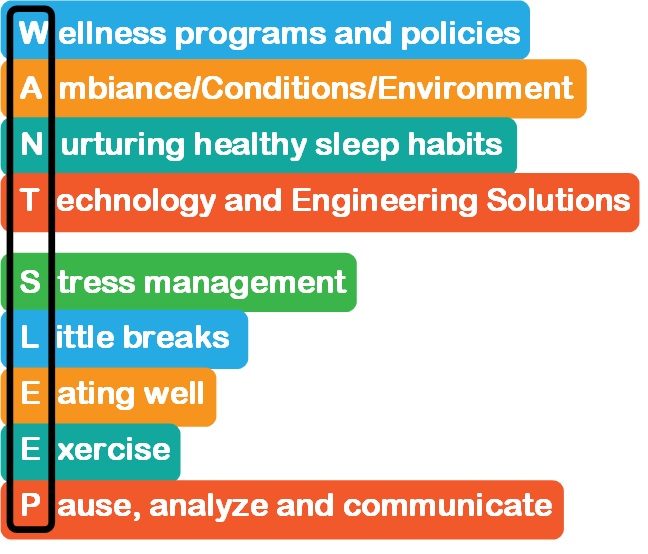
- Wellness programs
- Ambiance/Conditions/Environment
- Nurturing healthy sleeping habits
- Technology and Engineering Solutions
- Stress management
- Little breaks
- Eating well
- Exercise
- Pause, analyze and communicate
1. Wellness programs and policies
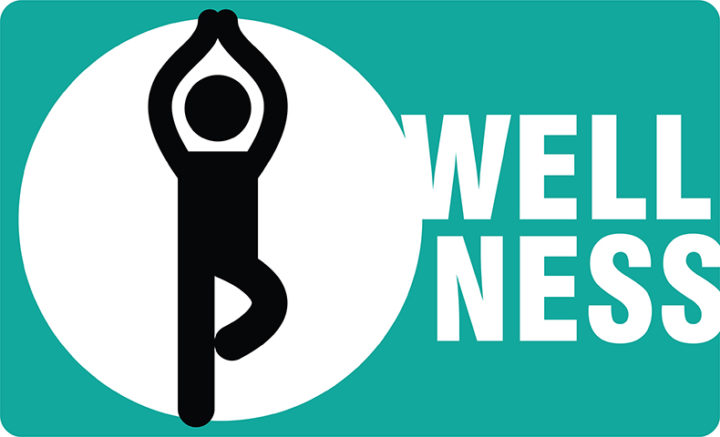
Wellness programs can be a significant investment, but their results can be seen in better employee engagement, fewer absences and better employee health, all of which will lead to an improved health and safety record and better production. Such programs and policies often include:
- health education
- medical screenings for sleeping disorders
- prevention programs, including smoking cessation, weight management, exercise and healthy eating promotion
- on-site fitness programs/facilities or discounted group rates at external facilities
- allowing flex-time for later starts, earlier finishes or exercise
- extended rest breaks
- offering healthy food options in vending machines and cafeterias
2. Ambiance/Conditions/Environment
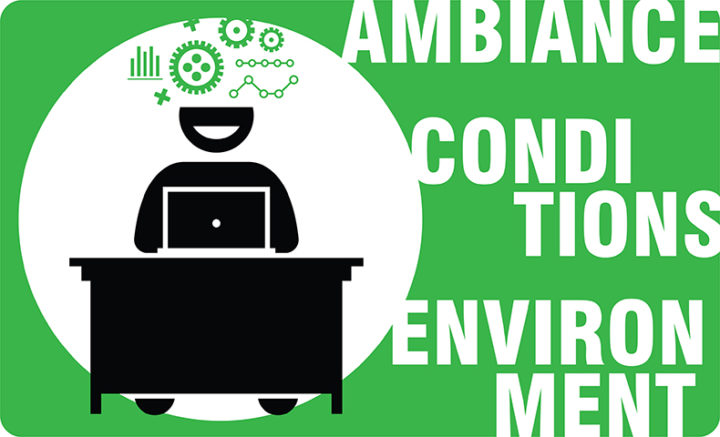
People’s circadian rhythms can be easily disrupted by not enough natural light, which can exacerbate feelings of fatigue. In addition, a small change in temperature can also have a significant impact on energy levels and performance.
Bright light aids in wakefulness and increases productivity, but can lead to problems with people’s internal clocks. Although artificial lighting may fool a person’s mind into thinking it’s daytime, their body requires natural light to perform at an optimal level. Natural light makes people less sleepy and helps them perform better for longer. This means that providing natural lighting whenever possible can help stave off fatigue.
Temperature can also affect fatigue levels. Lower temperature requires energy to be diverted from the brain to heat up the rest of the body. When that happens, the brain is more likely to underperform and people are much more prone to making mistakes. Ensuring a comfortable workplace temperature can prevent this from happening.
Consideration should be given to the environment of each person’s work. Do they have to go up and downstairs, walk distances, lift items repeatedly? Anything that can be automated to reduce unnecessary motion or assist with weight can not only lessen fatigue but also improve productivity.
Fluctuations in working conditions due to seasonality, cyclical production demands or a temporary heating or air conditioning failure needs to be taken into consideration in terms of how they can deviate from the usual levels to which workers are acclimatized.
3. Nurturing healthy sleeping habits
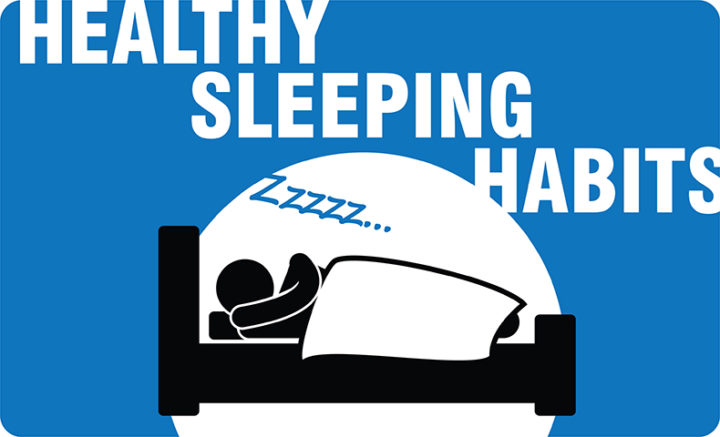
Although employees’ lives outside the company may seem like none of the employers’ business, their health and safety are just as important off the clock as they are when they’re in the workplace. Companies should consider educating their workers on the importance of sleep. Providing free materials and education on sleep hygiene and sleep health can contribute to staff getting more rested as a result.
It may also encourage them to take naps at home without feeling like they’re wasting time. This is important because many studies have shown that short power naps (10-30 min) increase performance by 34 percent and alertness by 54 percent. Naps as short as 10 minutes can improve alertness, communication and mood. Some companies even provide “nap rooms” and actively encourage employees to use them because they know that naps can boost productivity, critical thinking and creativity.
Unfortunately, few organizations can offer their employees the opportunity to take a short nap during their shift. In most cases, it’s simply not practical. As the next-best option, helping them get better sleep at home can make a huge difference in their levels of fatigue and, as a result, improve their health, safety and performance.
Although employers have no way of ensuring that workers get enough, good-quality sleep, it’s worth educating them on the significant risks of fatigue at and outside of work. Training sessions, guides, and webinars on the subject are a good way to help employees recognize the value of sufficient sleep. You can find relevant guides online or create your own. Whatever resource you choose to use, make sure it includes the following advice:
- Develop a pre-bedtime routine. This will help your body learn that performing certain actions means that it’s almost time to go to sleep.
- Your bedroom should be cool and dark.
- All technology should be removed from the bedroom. Screens are a distraction and their light also interferes with circadian rhythms. Regularly using a computer late at night is associated with sleep disorders, stress and depressive symptoms.
- Your brain needs to equate your bedroom with sleep. Exposing your brain to mixed messages—such as watching television or working in bed—means that it won’t associate pillows and sheets with sleep.
- Avoid stimulants like caffeine, tobacco and alcohol before bed as they interfere with your body’s natural rhythms.
4. Technology and Engineering Solutions
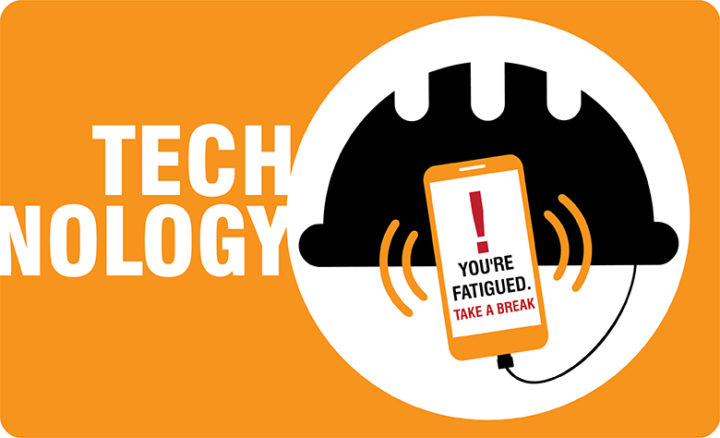
The number of wearable devices designed to track fatigue is expanding, and the customer base has grown far beyond the typical consumer. These days, numerous companies provide different industries with specialized equipment such as:
- drowsiness-detection glasses
- hats measuring brain activity
- head and facial movement monitors
- wearable technology
- fit-for-duty apps or assessments
Tools and devices designed to track fatigue can be extremely useful in preventing serious incidents in which fatigue is a factor, especially when the information gathered by some of these devices can be automatically sent to the management or supervisors. This data could prove critical in industries where a supervisor can make an informed decision about giving heavily fatigued workers safer work assignments, rearranging the schedule or providing other real-time interventions.
In high-risk industries, safety managers can use fatigue-tracking technology to see at a glance how fatigued each worker is, identify critical risks and then take steps to address the situation. But it’s important to remember that this can’t replace good old-fashioned communication, feedback and having a culture that supports open dialogue around fatigue.
Fatigue-monitoring devices can’t stop fatigue, inform workers what to do if they’re tired, or rest on their behalf. They can only provide information. So it’s up to organizations and their workers to make the right decisions.
When it comes to engineering solutions, organizations should consider things such as anti-fatigue mats, conveyor belts, tools that hang from above to prevent bending and lifting, etc. Even small changes in the environment can contribute to reducing strain and fatigue.
5. Stress management
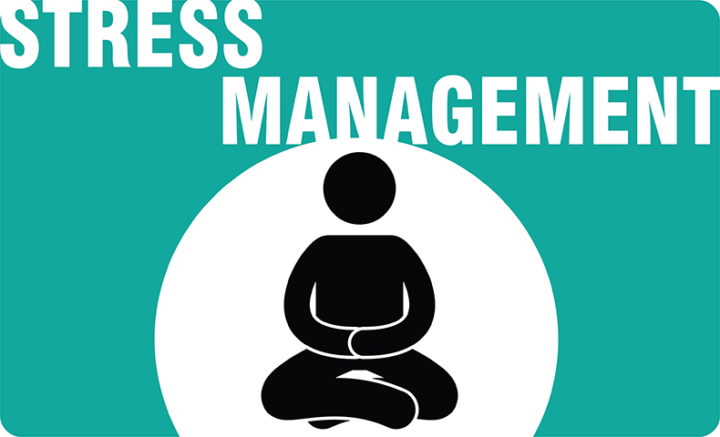
Stress can have a significant impact on fatigue. In fact, constant and prolonged stress is exhausting and detrimental to mental and physical health.
Some managers believe that pressure might make employees work faster, and it will—up to a point. But soon enough, fatigue will catch up and the consequences of stress will cost the company in health expenses, lost-time incidents, and decreased productivity. An employee who works in a friendly, relaxed setting performs much better than someone who feels constantly under pressure. And a relaxed work climate is possible even in highly dangerous and stressful jobs—because it’s about the work climate and not the job itself.
Some employers try to help their staff manage stress and other aspects of their lives by offering flexible hours, long vacations, half-day Fridays, stress-reduction classes and even yoga. In general, creating social activities for employees is good for boosting morale and reducing stress. Even simply providing a “chill-out space” can go a long way.
Additionally, communicating with workers can contribute to improved well-being because keeping employees informed about the company and their own performance reduces feelings of stress and anxiety.
Supervisors and team communication play a key role here too. Leaders need to be able to recognize the signs of stress in their team and understand how the many sources of stress cross over from work to home and vice versa.
6. Little breaks
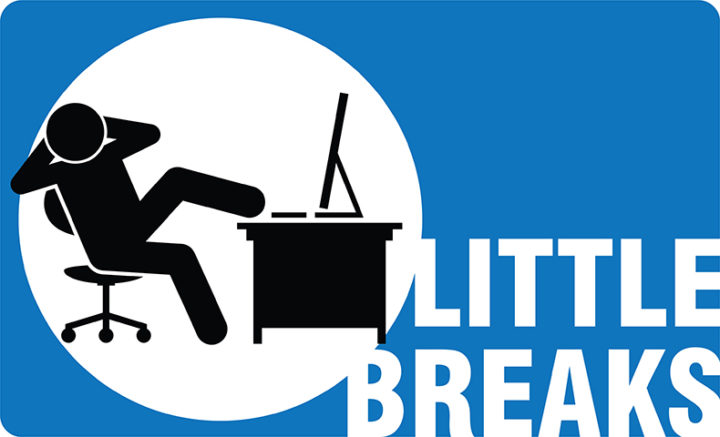
Every eighty to a hundred minutes, people’s concentration and attention levels drop, fatigue sets in, and their performance suffers. This is a signal that it’s time to stop and take a break. These breaks can be simple trips to the bathroom, walking to speak to a colleague instead of sending a message, or simply taking a couple of minutes to walk around, stretch and look out the window.
People’s brains and bodies are not capable of continuous performance at a steady level for eight or nine hours straight—everyone experiences dips in alertness and concentration throughout the day. Recovery breaks are a proven method of allowing the brain to rest and perform better for longer.
Taking multiple short breaks can improve performance and well-being and is better for employees than working a straight shift with one break in the middle. Shifts could be scheduled accordingly to break them up with several recovery breaks.
The intensity and conditions of the work should also correlate to the frequency and duration of breaks. Someone lifting heavy objects in extreme heat requires significantly more recovery time than someone monitoring systems from a seated position in an air-conditioned room. Ideally, supervisors need to have strategies to plan work and distribute it evenly among their team wherever possible.
Companies should consider encouraging workers to take short breaks to:
- Get up and walk around
- Look out the window for a few minutes
- Stretch
- Get a drink
- Talk to someone
- Alternate demanding and less-demanding tasks with a partner
This can lead to employees who feel less fatigued and are more likely to notice safety hazards and make safer decisions.
7. Eating well
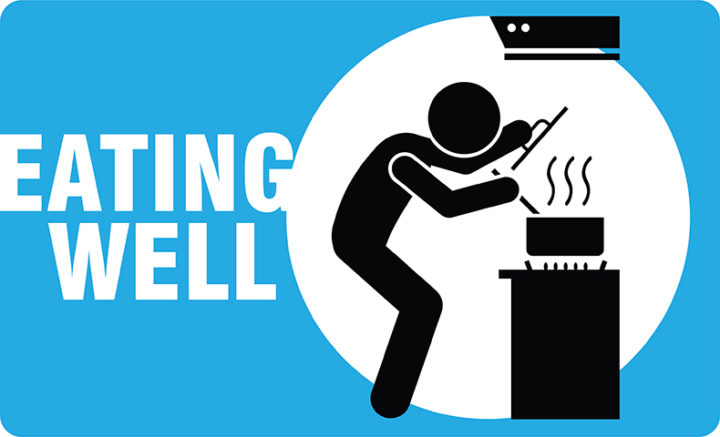
Nutrition
Although it might seem like nutrition is not relevant to fatigue, it actually has a huge impact on energy levels. This is why it’s worth providing workers with a nutrition class or information to encourage certain behaviors and habit changes related to eating. The guides could include advice such as:
- Have a decent breakfast. Providing your body with the right type of energy at the beginning of the day will keep you going for longer.
- Eat more frequent but smaller meals instead of two or three big meals in the day. This will help steady your blood sugar levels and energy levels.
- Choose lean proteins, healthy fats, and lots of greens instead of processed, refined carbs. These will help to keep you full for longer and maintain your blood sugar at an even level, preventing energy spikes and dips.
Recognizing that healthy food has a positive impact on employees, the Centers for Disease Control and Prevention provides guidelines for choosing foods and beverages for meetings, conferences and events. This can also apply to staff rooms if the employer chooses to stock it with healthy foods and snacks.
Hydration
Even mild dehydration can have a negative impact on performance and alertness. It increases feelings of sluggishness and slows people down. To address the issue, it’s worth keeping in mind that when it comes to hydration, not all liquids are created equal.
Soda and sugary drinks will give a person a short-lived energy boost, but it’s soon followed by a crash and an increase in fatigue. It’s best to hydrate with water—a water cooler in the workplace is always a good idea, as is making sure that the employees have easy access to it.
Some people use caffeine to hydrate and stay awake. But caffeine is a stimulant that works best when used strategically because its effects can last up to six hours and can interfere with the body’s natural rhythms. Additionally, just like soft drinks, alcohol or salty foods, caffeine can contribute to dehydration.
It’s even more important to encourage workers to hydrate in hot working environments because people require more liquids than usual in these environments. It’s a good idea to hand out water to staff on a regular basis and provide them with regular reminders to hydrate.
8. Exercise
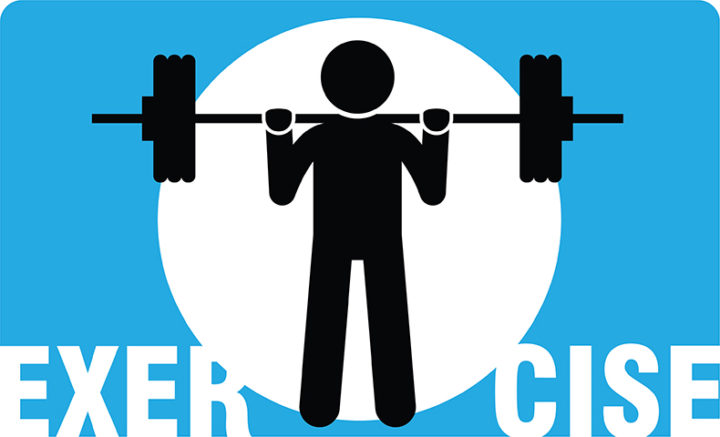
Studies have shown that exercise helps relieve stress, boost overall health, and strengthen immune function. It’s also been proven that physical activity increases energy levels and reduces fatigue. And exercise routines don’t even have to be strenuous. Research shows that people who engage in low-intensity exercise three times a week have a 65 percent reduction in fatigue levels. Simply going out for a short leisurely walk a few times a week is extremely helpful in lowering fatigue levels.
Even people who lead a sedentary life and choose to engage in regular, low-intensity exercise can increase their energy levels by 20 percent. So although it might not seem very appealing, it’s possible to start with simple, low-impact exercises and results will soon follow. Encouraging exercise breaks can contribute to a fitter, healthier and less fatigued workforce.
9. Pause, analyze and communicate
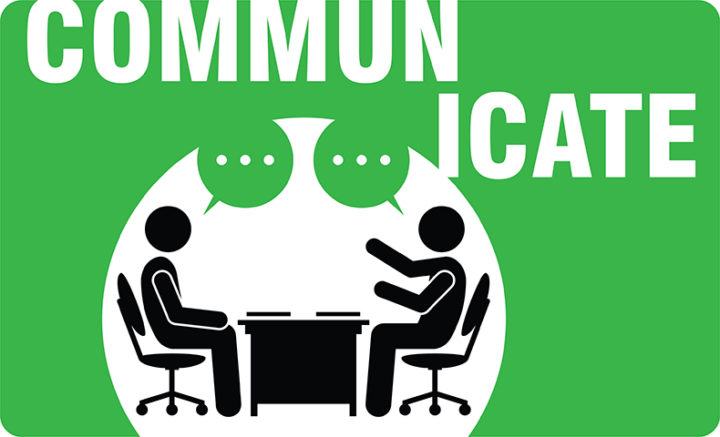
Lack of sleep can impair a person’s ability to gauge if they’re tired. That’s because the first part of the brain that is affected by lack of sleep is the part that recognizes fatigue. So it’s important to train workers on how to recognize objective signs and symptoms of fatigue, and then encourage them to regularly take a clear-eyed look at their performance and consider the possibility that they might need a break.
People need to know that if they’re tired, they need to address the problem. Just because they’ve done something many times before without incident doesn’t mean that fatigue won’t cause them to get distracted or make a mistake this time.
If your workplace struggles with managing worker fatigue, it might be worth implementing a buddy system. When people watch out for fatigue symptoms in each other, they become more likely to catch it and help their colleagues avoid a serious mistake or injury. When implementing a buddy system, make sure people know to watch out for:
- droopy eyes
- slower movements
- irritability
- lack of concentration
- long blinks
They should also know how to positively intervene if they notice these signs so that they can effectively encourage each other to take breaks when necessary.
It’s not enough for individuals to pause and recognize their own fatigue. They need to relay that information to their supervisor. But the supervisor needs to have established a climate for encouraging that communication as well as know HOW to communicate about the subject, especially when they pause and analyze their workers for signs of fatigue themselves.
This two-way feedback loop can help mitigate fatigue reaching critical levels and it can also identify elements of the system or working conditions that can potentially increase worker fatigue. Issues can then be relayed upwards to management and improvements can be made for the future.
The state-of-mind pattern
Complacency
It’s important to address fatigue in the context of complacency. It’s natural for people to build habits around certain aspects of their life that are far from safe because they do those tasks all the time. For example, most people are likely to not give driving the full attention it deserves even though it’s an incredibly dangerous task.
This is not necessarily caused by deliberate choices but by misperception of risk. After all, when someone has been performing a task for years, they are more comfortable with it and may not see it as dangerous anymore. They might even stop paying attention and perform it on autopilot.
As a result, people regularly drive and work fatigued. They do it because they don’t think they’re fatigued or because they believe they can do it safely despite being fatigued. Not noticing that they’re tired is just as dangerous as noticing it but not doing anything about it because nothing bad has ever happened before.
This is one of the many reasons why it’s important to address complacency and other human factors in safety training. With the right training, workers will be able to minimize the costly or deadly mistakes caused by ignoring fatigue and trying to push through.
Other states of mind
The task of dealing with fatigue can seem much more serious when we add complacency and other states of mind into the mix. But focusing on the universal problem of human performance instead of one small part of it is more efficient.
States such as rushing, frustration and complacency lead to physical and mental errors and compromised decisions. And when you add fatigue into the mix, the consequences could be deadly. The ideal solution is to provide awareness and skills to help employees mitigate the risks of human factors. Typically, this is best done via human factors training that focuses on common patterns and teaches people to understand and manage their states—including fatigue.
Conclusion
All this information above may seem a little overwhelming. There are so many factors that affect fatigue that it’s natural for safety professionals to struggle with at least some of the elements mentioned here.
However, all of the factors outlined in this post can have a significant impact on safety. Consider which fatigue-related issues deserve the most attention and then create a plan that works best for you and your employees. For example, this could include regular toolbox talks. Each meeting could focus on a separate issue addressed here and include relevant handouts and other useful materials that will support workers as they attempt to reduce their overall levels of fatigue.
-
give employees information about fatigue risks
-
offer skills and habits to manage fatigue
-
address the common pattern of states that increase the risk of injury
And, ideally you’ll establish two-way communication and feedback loops so that information on the things that are most urgently impacting fatigue can get from the frontline workers to upper management.
Your plan should include three components:
- Workplace fatigue risk management
- Worker and family fatigue program
- Training
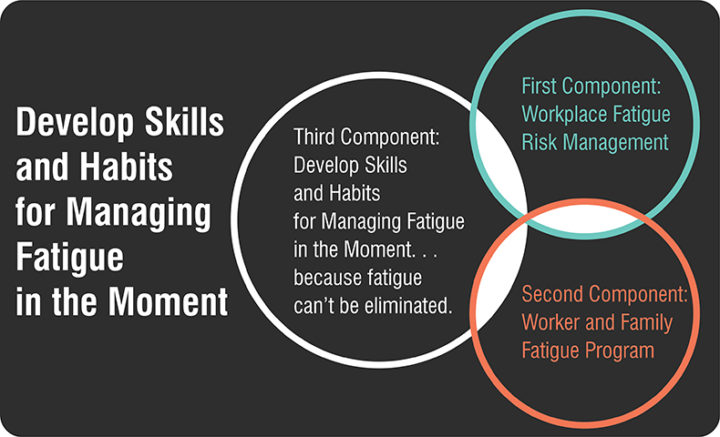
Each of those components involves separate areas of focus. Workplace fatigue risk management could include:
- providing healthy nutrition and hydration as well as education on the subject
- implementing a buddy system
- addressing an unreasonable work schedule
- scheduling adequate and regular breaks
- preventing dark or cold environments
- providing support through wellness programs and stress management
- adopting relevant technology
Meanwhile, worker and family fatigue program should address:
- sleep deprivation
- poor diets
- a lack of exercise
Training should include skills and habits for managing fatigue in the moment and addressing related states that, when combined with fatigue, can lead to serious incidents. Among others, states that should be addressed are:
- complacency
- rushing
- frustration
- distraction
- confusion
Even though some of these factors might not affect your workforce as much as others, consider addressing all of these fatigue-influencing elements. Some may affect your workers without you realizing it. And your advice might help keep your workers safe at home and on the road, in addition to protecting them at work from the dangers of fatigue.

